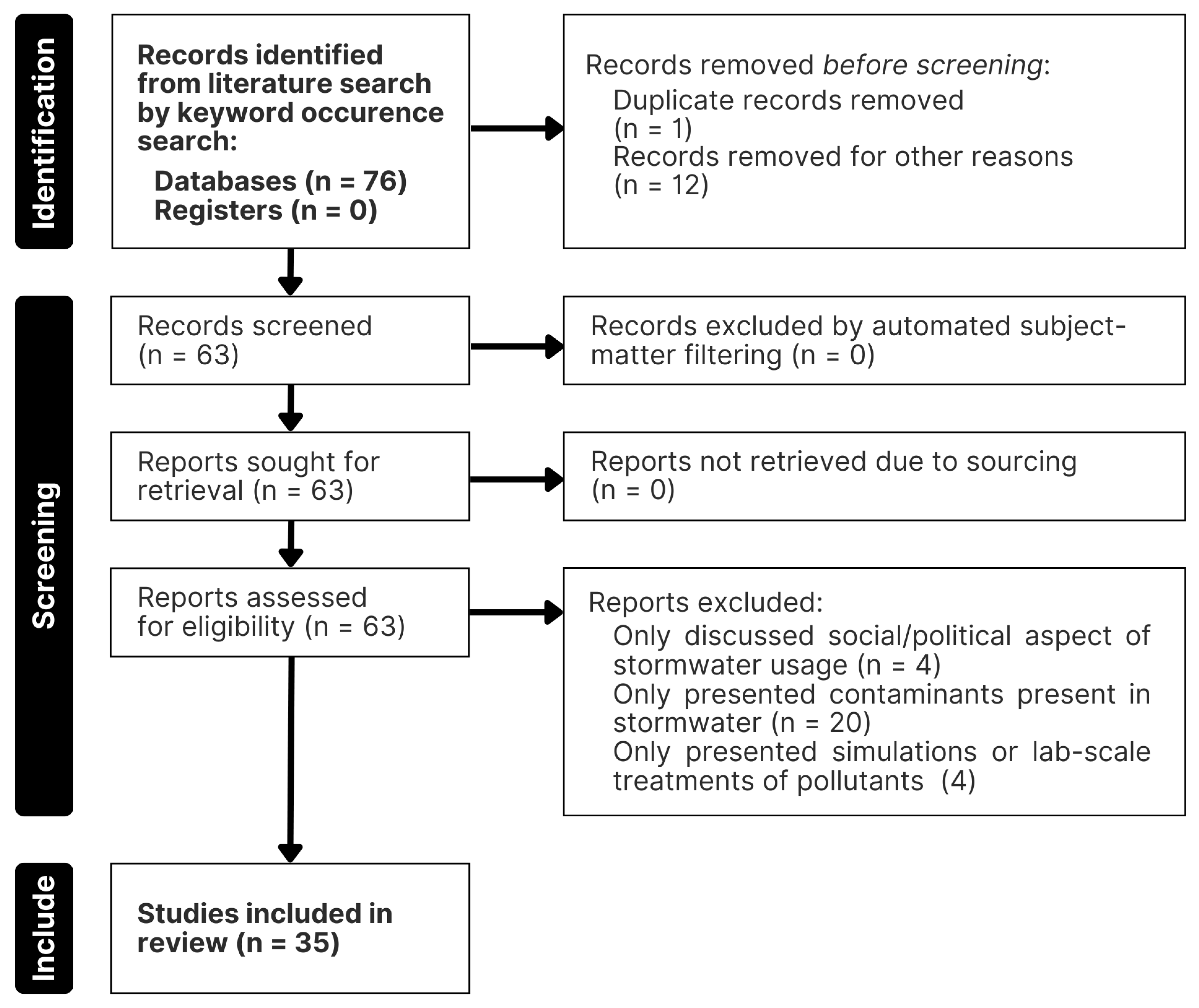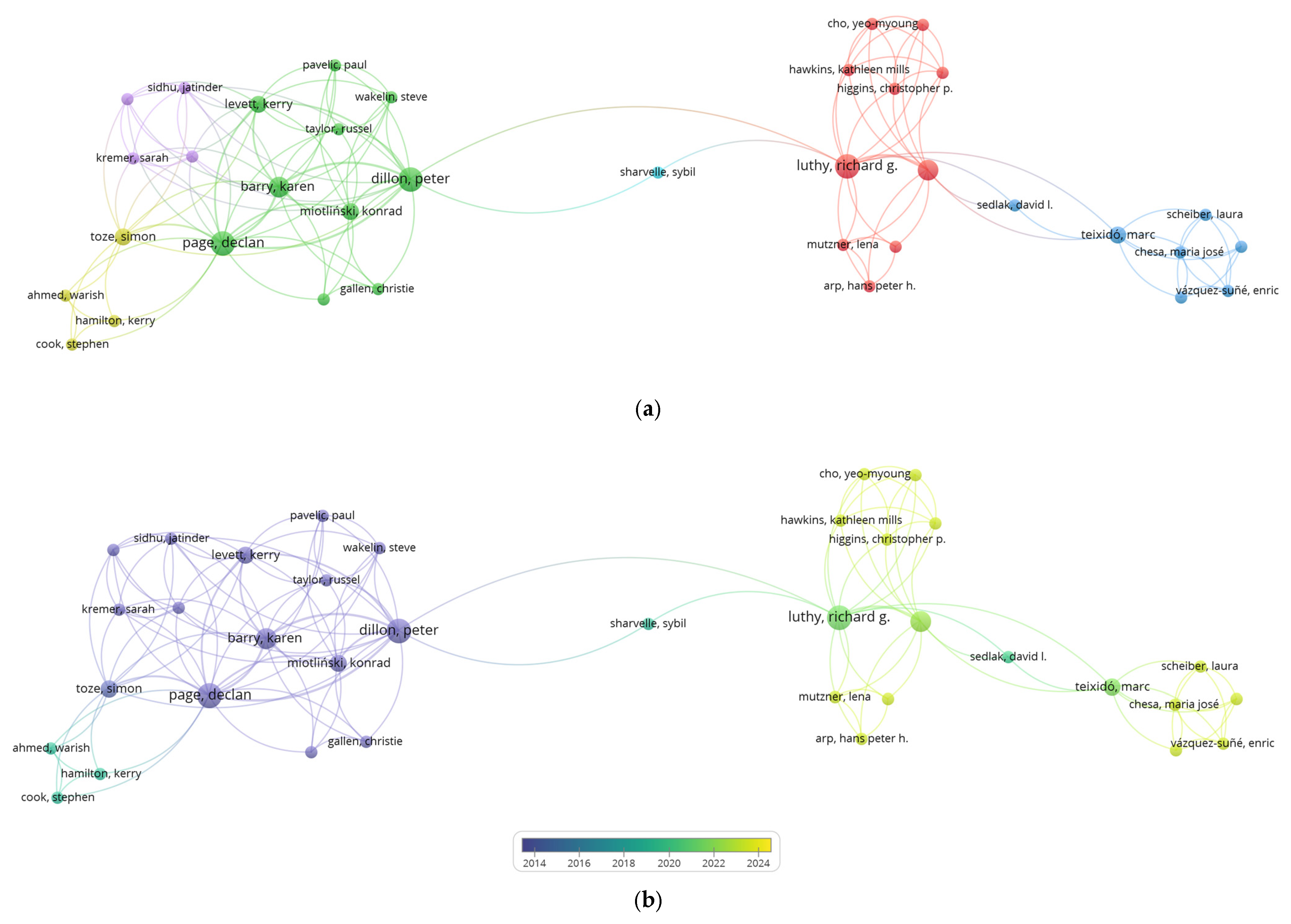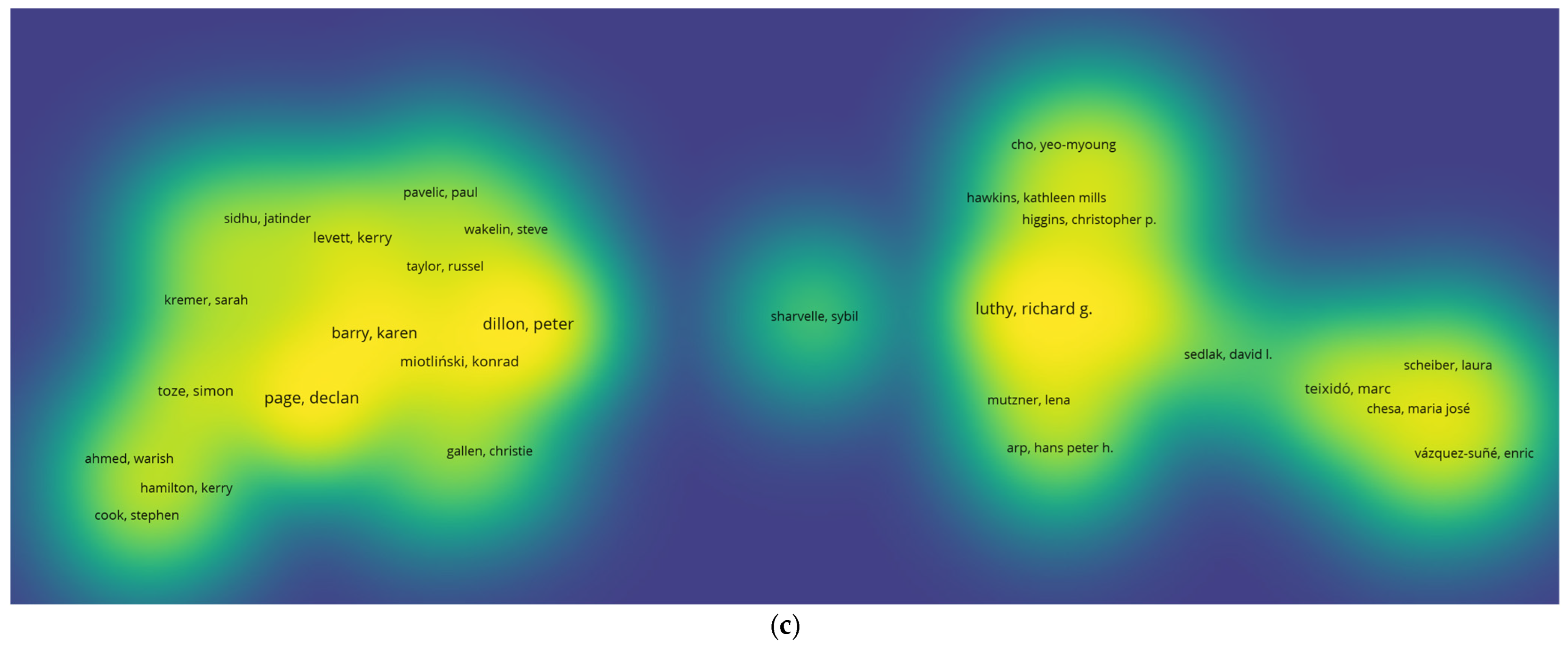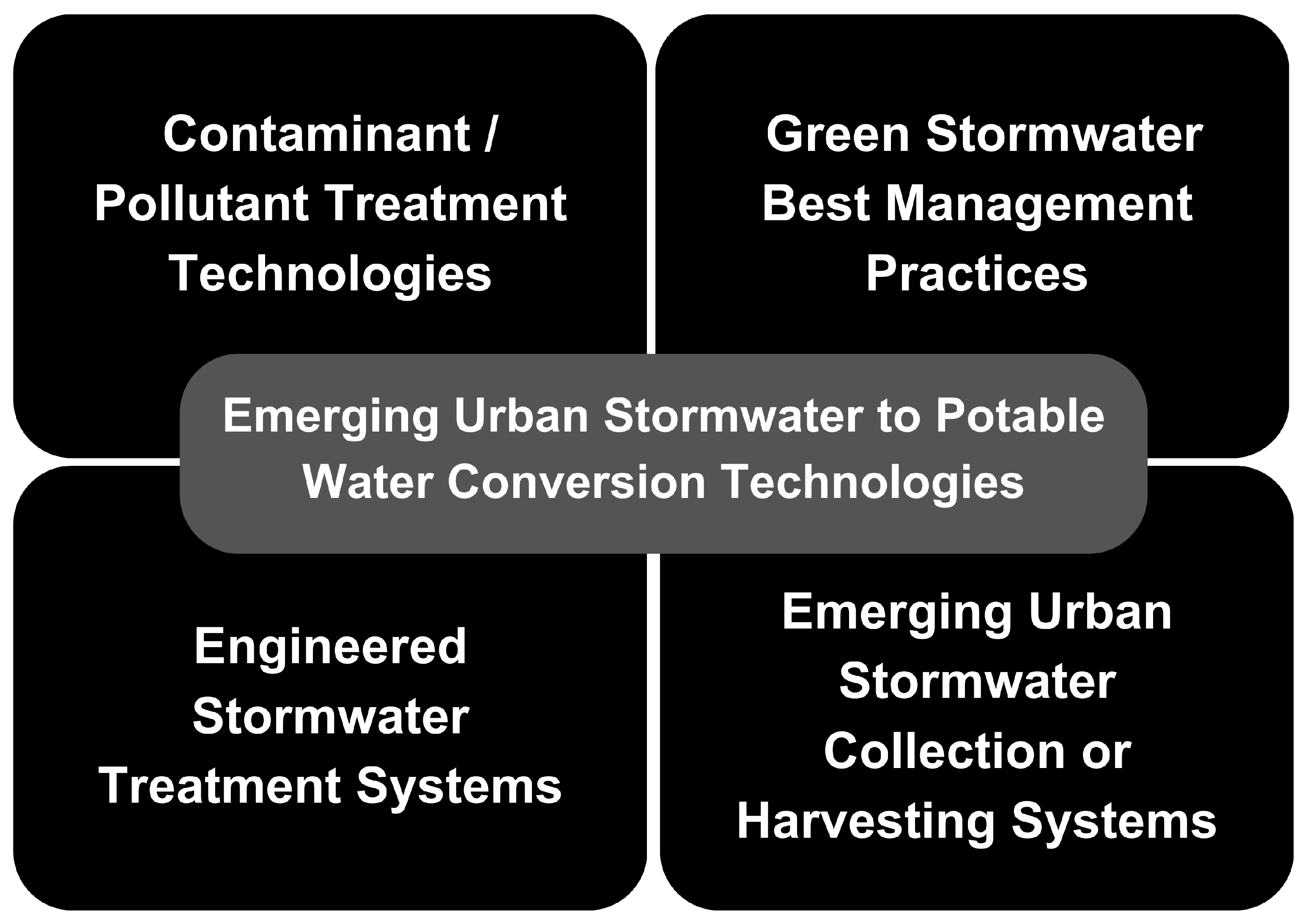Mitigating the Global Potable Water Crisis: A Systematic Review of Emerging Urban Stormwater Conversion Technologies †
Abstract
1. Introduction
2. Methodology
3. Bibliometric Analysis
3.1. Co-Authorship
3.2. Co-Occurrence
4. Emerging Technologies
5. Trajectories of Research
6. Conclusions
Author Contributions
Funding
Institutional Review Board Statement
Data Availability Statement
Conflicts of Interest
References
- United Nations. Population|United Nations. Available online: https://www.un.org/en/global-issues/population (accessed on 27 November 2024).
- Deksissa, T. Urban Stormwater Runoff for Potable Use: Potential and Challenges. In Alternative Water Sources for Producing Potable Water: Advances in Research & Technology; Springer: Berlin/Heidelberg, Germany, 2023; pp. 71–96. [Google Scholar]
- United Nations. Urbanization|Population Division. Available online: https://www.un.org/development/desa/pd/content/urbanization-0 (accessed on 27 November 2024).
- United Nations. 68% of the World Population Projected to Live in Urban Areas by 2050, Says UN|United Nations. Available online: https://www.un.org/uk/desa/68-world-population-projected-live-urban-areas-2050-says-un (accessed on 27 November 2024).
- Page, D.; Miotliński, K.; Dillon, P.; Taylor, R.; Wakelin, S.; Levett, K.; Barry, K.; Pavelic, P. Water Quality Requirements for Sustaining Aquifer Storage and Recovery Operations in a Low Permeability Fractured Rock Aquifer. J. Environ. Manag. 2011, 92, 2410–2418. [Google Scholar] [CrossRef] [PubMed]
- Ahmed, W.; Hamilton, K.; Toze, S.; Cook, S.; Page, D. A Review on Microbial Contaminants in Stormwater Runoff and Outfalls: Potential Health Risks and Mitigation Strategies. Sci. Total Environ. 2019, 692, 1304–1321. [Google Scholar] [CrossRef] [PubMed]
- UNESCO. The United Nations World Water Development Report 2023: Partnerships and Cooperation for Water; UNESCO: Paris, France, 2023. [Google Scholar]
- Regnery, J.; Gerba, C.P.; Dickenson, E.R.V.; Drewes, J.E. The Importance of Key Attenuation Factors for Microbial and Chemical Contaminants during Managed Aquifer Recharge: A Review. Crit. Rev. Environ. Sci. Technol. 2017, 47, 1409–1452. [Google Scholar] [CrossRef]
- Mutzner, L.; Zhang, K.; Luthy, R.G.; Arp, H.P.H.; Spahr, S. Urban Stormwater Capture for Water Supply: Look out for Persistent, Mobile and Toxic Substances. Environ. Sci. 2023, 9, 3094–3102. [Google Scholar] [CrossRef]
- Lundy, L.; Revitt, M.; Ellis, B. An Impact Assessment for Urban Stormwater Use. Environ. Sci. Pollut. Res. 2018, 25, 19259–19270. [Google Scholar] [CrossRef]
- Inamdar, P.M.; Cook, S.; Sharma, A.K.; Corby, N.; O’Connor, J.; Perera, B.J.C. A GIS Based Screening Tool for Locating and Ranking of Suitable Stormwater Harvesting Sites in Urban Areas. J. Environ. Manag. 2013, 128, 363–370. [Google Scholar] [CrossRef]
- Page, D.; Miotliński, K.; Gonzalez, D.; Barry, K.; Dillon, P.; Gallen, C. Environmental Monitoring of Selected Pesticides and Organic Chemicals in Urban Stormwater Recycling Systems Using Passive Sampling Techniques. J. Contam. Hydrol. 2014, 158, 65–77. [Google Scholar] [CrossRef]
- Luthy, R.G.; Sharvelle, S.; Dillon, P. Urban Stormwater to Enhance Water Supply. Environ. Sci. Technol. 2019, 53, 5534–5542. [Google Scholar] [CrossRef]
- Tang, J.Y.M.; Aryal, R.; Deletic, A.; Gernjak, W.; Glenn, E.; McCarthy, D.; Escher, B.I. Toxicity Characterization of Urban Stormwater with Bioanalytical Tools. Water Res. 2013, 47, 5594–5606. [Google Scholar] [CrossRef]
- Zhang, S.; Jing, X. Hydrologic Design and Economic Benefit Analysis of Rainwater Harvesting Systems in Shanghai, China. In Proceedings of the International Low Impact Development Conference China, Beijing, China, 26–29 June 2016; American Society of Civil Engineers: Reston, VA, USA, 2017; pp. 381–389. [Google Scholar]
- Lim, K.-Y.; Hamilton, A.J.; Jiang, S.C. Assessment of Public Health Risk Associated with Viral Contamination in Harvested Urban Stormwater for Domestic Applications. Sci. Total Environ. 2015, 523, 95–108. [Google Scholar] [CrossRef]
- Wang, W.; Zhang, P.; Ye, X. Study on Rainfall and Roof Rainwater Quality Changes Oriented to Stormwater Recycling. In Proceedings of the 2010 4th International Conference on Bioinformatics and Biomedical Engineering, Chengdu China, 18–20 June 2010. [Google Scholar]
- Almeida, A.P.; Liberalesso, T.; Silva, C.M.; Sousa, V. Combining Green Roofs and Rainwater Harvesting Systems in University Buildings under Different Climate Conditions. Sci. Total Environ. 2023, 887, 163719. [Google Scholar] [CrossRef] [PubMed]
- Laurenson, G.; Laurenson, S.; Bolan, N.; Beecham, S.; Clark, I. The Role of Bioretention Systems in the Treatment of Stormwater. Adv. Agron. 2013, 120, 223–274. [Google Scholar]
- Page, D.W.; Vanderzalm, J.L.; Barry, K.E.; Torkzaban, S.; Gonzalez, D.; Dillon, P.J. E. coli and Turbidity Attenuation during Urban Stormwater Recycling via Aquifer Storage and Recovery in a Brackish Limestone Aquifer. Ecol. Eng. 2015, 84, 427–434. [Google Scholar] [CrossRef]
- Page, D.; Dillon, P.; Vanderzalm, J.; Toze, S.; Sidhu, J.; Barry, K.; Levett, K.; Kremer, S.; Regel, R. Risk Assessment of Aquifer Storage Transfer and Recovery with Urban Stormwater for Producing Water of a Potable Quality. J. Environ. Qual. 2010, 39, 2029–2039. [Google Scholar] [CrossRef]
- Devitt, C. Urban Stormwater Supplies Drinking Water at Orange, NSW. Water 2010, 37, 75–79. [Google Scholar]
- Li, Y.L.; Deletic, A.; McCarthy, D.T. Removal of E. coli from Urban Stormwater Using Antimicrobial-Modified Filter Media. J. Hazard. Mater 2014, 271, 73–81. [Google Scholar] [CrossRef]
- Page, D.; Gonzalez, D.; Torkzaban, S.; Toze, S.; Sidhu, J.; Miotliński, K.; Barry, K.; Dillon, P. Microbiological Risks of Recycling Urban Stormwater via Aquifers for Various Uses in Adelaide, Australia. Environ. Earth Sci. 2015, 73, 7733–7737. [Google Scholar] [CrossRef]
- Page, D.; Gonzalez, D.; Dillon, P. Microbiological Risks of Recycling Urban Stormwater via Aquifers. Water Sci. Technol. 2012, 65, 1692–1695. [Google Scholar] [CrossRef]
- Fong, L.M.; Nazarudeen, H. Collection of Urban Stormwater for Potable Water Supply in Singapore. Singap. Public Util. Board Water Quality International, May/June, 1996; 36–40. [Google Scholar]
- Bugan, R.D.H.; Jovanovic, N.; Israel, S.; Tredoux, G.; Genthe, B.; Steyn, M.; Allpass, D.; Bishop, R.; Marinus, V. Four Decades of Water Recycling in Atlantis (Western Cape, South Africa): Past, Present and Future. Water SA 2016, 42, 577. [Google Scholar] [CrossRef]
- Singh, A.; Ayoko, G.A.; Herngren, L.; Goonetilleke, A. A Multivariate Approach to the Identification of Surrogate Parameters for Heavy Metals in Stormwater. Water Air Soil Pollut. 2013, 224, 1368. [Google Scholar] [CrossRef][Green Version]
- Wright, A.; Parsons, R. Artificial Recharge of Urban Wastewater, the Key Component in the Development of an Industrial Town on the Arid West Coast of South Africa. In Proceedings of the Water Down Under 1994 Conference, Adelaide, South Australia, 21–25 November 1994; National Conference Publication—Institution of Engineers: Stellenbosch, Australia, 1994. [Google Scholar]
- Hudak, J.P. Planning and Constructing Urban Stormwater Discharge Retrofits: The Lake Whitney Urban Runoff Project. J. N. Engl. Water Work. Assoc. 1996, 110, 175–179. [Google Scholar]
- Akter, A. Economics of Rainwater Harvesting System. In Rainwater Harvesting—Building a Water Smart City; Springer International Publishing: Cham, Switzerland, 2022; pp. 215–225. [Google Scholar]
- Emelko, M.B.; Tufenkji, N.; Stone, M.; Rudolph, D.L.; Marsalek, J. Mitigation of Urban Stormwater and Polluted River Water Impacts on Water Quality with Riverbank Filtration. In Effects of Urbanization on Groundwater; American Society of Civil Engineers: Reston, VA, USA, 2010; pp. 165–198. [Google Scholar]
- Fan, S.; Wen, G.; Liu, A. Urban Stormwater Disinfection, Quality Variability during Storage and Influence on the Freshwater Algae: Implications for Reuse Safety. J. Environ. Sci. 2023, 124, 655–666. [Google Scholar] [CrossRef] [PubMed]
- Zhang, D.; Gersberg, R.M.; Ng, W.J.; Tan, S.K. Conventional and Decentralized Urban Stormwater Management: A Comparison through Case Studies of Singapore and Berlin, Germany. Urban Water J. 2017, 14, 113–124. [Google Scholar] [CrossRef]
- Younos, T. Paradigm Shift: Holistic Approach for Water Management in Urban Environments. Front. Earth Sci. 2011. [CrossRef]
- Wang, Y.; Yin, H.; Liu, Z.; Wang, X. A Systematic Review of the Scientific Literature on Pollutant Removal from Stormwater Runoff from Vacant Urban Lands. Sustainability 2022, 14, 12906. [Google Scholar] [CrossRef]
- Jusić, S.; Hadžić, E.; Milišić, H. Urban Stormwater Management—New Technologies. In New Technologies, Development and Application II; Lecture Notes in Networks and Systems; Springer International Publishing: Cham, Switzerland, 2020; pp. 790–797. [Google Scholar] [CrossRef]






Disclaimer/Publisher’s Note: The statements, opinions and data contained in all publications are solely those of the individual author(s) and contributor(s) and not of MDPI and/or the editor(s). MDPI and/or the editor(s) disclaim responsibility for any injury to people or property resulting from any ideas, methods, instructions or products referred to in the content. |
© 2025 by the authors. Licensee MDPI, Basel, Switzerland. This article is an open access article distributed under the terms and conditions of the Creative Commons Attribution (CC BY) license (https://creativecommons.org/licenses/by/4.0/).
Share and Cite
Mendoza, K.G.C.; Rupin, M.D.J.V.; Rubi, R.V. Mitigating the Global Potable Water Crisis: A Systematic Review of Emerging Urban Stormwater Conversion Technologies. Environ. Earth Sci. Proc. 2025, 32, 8. https://doi.org/10.3390/eesp2025032008
Mendoza KGC, Rupin MDJV, Rubi RV. Mitigating the Global Potable Water Crisis: A Systematic Review of Emerging Urban Stormwater Conversion Technologies. Environmental and Earth Sciences Proceedings. 2025; 32(1):8. https://doi.org/10.3390/eesp2025032008
Chicago/Turabian StyleMendoza, Kylle Gabriel Cruz, Marc Deo Jeremiah Victorio Rupin, and Rugi Vicente Rubi. 2025. "Mitigating the Global Potable Water Crisis: A Systematic Review of Emerging Urban Stormwater Conversion Technologies" Environmental and Earth Sciences Proceedings 32, no. 1: 8. https://doi.org/10.3390/eesp2025032008
APA StyleMendoza, K. G. C., Rupin, M. D. J. V., & Rubi, R. V. (2025). Mitigating the Global Potable Water Crisis: A Systematic Review of Emerging Urban Stormwater Conversion Technologies. Environmental and Earth Sciences Proceedings, 32(1), 8. https://doi.org/10.3390/eesp2025032008







